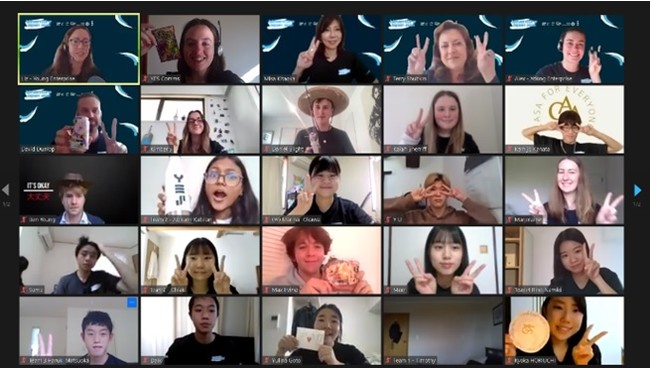Five high schoolers from across New Zealand have been crowned winners in the inaugural BizVenture Programme, a pilot initiative led by Education New Zealand and its Japanese partners to give Kiwi and Japanese students a first-hand experience conceiving business solutions that address the UN’s Sustainable Development Goals.
Forty specially selected students* from New Zealand and Japan collaborated in a three-day virtual exchange on September 18-20, where they chose one challenge addressing some of Japan’s pressing social issues, before designing and presenting a business plan in a ‘dragon’s den’ style pitch to judges.
Each team answered to one of three briefs surrounding relative poverty, gender equality or youth mental wellbeing.
The winning New Zealand team comprised of Hamish Robinson from Napier’s Taradale High School, Benjamin Young from Tauranga Boys College, Daniel Blight from Nelson’s Waimea College, Kaiah Sherriff from Southland Girls High School, and Abirami Kabilan of Auckland’s Pakuranga College – with the budding entrepreneurs choosing to tackle a solution that directly enhances the mental wellbeing of Japanese teenagers.

UNICEF reports rank Japan 37th amongst the 41 OECD countries for children’s mental health, assessed by factors including life satisfaction and suicide rates (New Zealand is in a similar position at 38th).
The Kiwi students successfully pitched a concept to develop a sustainable clothing brand called 大丈夫, which translates in English to “It’s Okay”, with the aim of promoting positive conversations around mental health amongst Japanese youth – including ambitions to gain the support of high-reach Japanese influencers to help push their critical wellbeing message.
“While a clothing brand in itself is not particularly creative, we feel our idea to use clothing as a way to push our message about the importance of mental health is,” their business plan explained. “Using clothing to spread our message is distinctly unique in Japan, a nation with negative stigma surrounding mental health.”
17-year-old Abirama Kabilan (Pakuranga College) said of her venture: “The UN SDGs are some of the biggest problems facing humanity today, so working on them was a pretty full-on task. Despite this, it was amazing to see what happens when a couple of young people put their heads together. One thing we all realised was that the SDGs are interlinked, so by working on one it puts us in a better position to target the others.”
Kabilan says the exposure to Japanese business and societal culture was eye-opening.
“One of the most interesting things about this cross-cultural experience was seeing how the Japanese students approached the same problems. Young people around the world in other countries will have such different ways of approaching these problems too, imagine the ideas we would come up with if we all worked together.”
Meanwhile, the Japanese winning team developed a business case for a new app to support Japanese fathers doing housework and actively bringing up children – a social dynamic challenge for Japan’s working mothers. This challenge was set in response to Japan’s rank as 120th in the gender gap index – worst among G7 countries – and the Japanese government not achieving its mandate to increase women in senior leadership roles to 30% by 2020 (currently at 15%).
The bilateral collaboration saw the students exposed to business and culture in both countries via a weekend of interactive workshops with New Zealand and Japanese guest speakers, cultural mentors and language coaches, in preparation for their pitches.
ENZ’s programme is designed to continually build on New Zealand’s diplomatic relationship with Japan when travel for international students is limited.
“Over many decades Japan and New Zealand have benefitted from an enduring partnership, and next year we will be celebrating 70 years of diplomatic relations. Education has played a really important role in fostering people-to-people ties, and supporting the development of what are now, in 2021, very close connections between our two countries,” says Hamish Cooper, New Zealand Ambassador to Japan.
“Before the pandemic, more than 10,000 students from Japan studied in New Zealand every year, making an important economic contribution, but also enriching our schools and communities, and helping New Zealand students become more globally connected.”
Following the pilot’s success, BizVenture collaborators have bigger plans for 2022.
“Our plan is to host BizVenture face-to-face in respective countries in the future and for winning teams to visit each other’s countries,” says Misa Kitaoka, Education New Zealand’s Director of Education for Japan. “We plan to fundraise and partner with business advocacy leaders and organisations in both countries to support students’ travel cost and/or implement their business ideas in the marketplace.”
BizVenture also served as an important show of commitment by the New Zealand and Japanese governments collectively working towards achieving UN Sustainable Development Goals.




























































